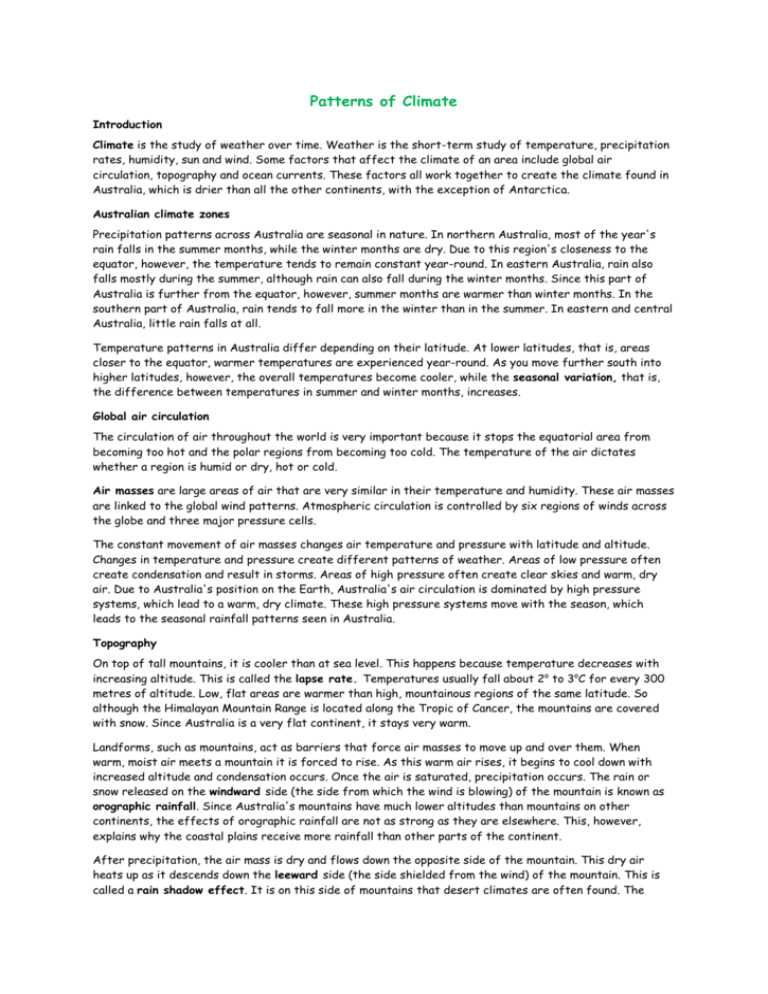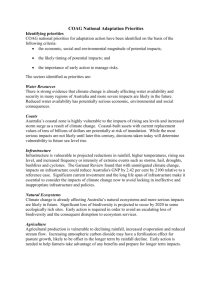Patterns of Climate - Year 10 Australian Geography St Marouns
advertisement

Patterns of Climate Introduction Climate is the study of weather over time. Weather is the short-term study of temperature, precipitation rates, humidity, sun and wind. Some factors that affect the climate of an area include global air circulation, topography and ocean currents. These factors all work together to create the climate found in Australia, which is drier than all the other continents, with the exception of Antarctica. Australian climate zones Precipitation patterns across Australia are seasonal in nature. In northern Australia, most of the year's rain falls in the summer months, while the winter months are dry. Due to this region's closeness to the equator, however, the temperature tends to remain constant year-round. In eastern Australia, rain also falls mostly during the summer, although rain can also fall during the winter months. Since this part of Australia is further from the equator, however, summer months are warmer than winter months. In the southern part of Australia, rain tends to fall more in the winter than in the summer. In eastern and central Australia, little rain falls at all. Temperature patterns in Australia differ depending on their latitude. At lower latitudes, that is, areas closer to the equator, warmer temperatures are experienced year-round. As you move further south into higher latitudes, however, the overall temperatures become cooler, while the seasonal variation, that is, the difference between temperatures in summer and winter months, increases. Global air circulation The circulation of air throughout the world is very important because it stops the equatorial area from becoming too hot and the polar regions from becoming too cold. The temperature of the air dictates whether a region is humid or dry, hot or cold. Air masses are large areas of air that are very similar in their temperature and humidity. These air masses are linked to the global wind patterns. Atmospheric circulation is controlled by six regions of winds across the globe and three major pressure cells. The constant movement of air masses changes air temperature and pressure with latitude and altitude. Changes in temperature and pressure create different patterns of weather. Areas of low pressure often create condensation and result in storms. Areas of high pressure often create clear skies and warm, dry air. Due to Australia's position on the Earth, Australia's air circulation is dominated by high pressure systems, which lead to a warm, dry climate. These high pressure systems move with the season, which leads to the seasonal rainfall patterns seen in Australia. Topography On top of tall mountains, it is cooler than at sea level. This happens because temperature decreases with increasing altitude. This is called the lapse rate. Temperatures usually fall about 2o to 3oC for every 300 metres of altitude. Low, flat areas are warmer than high, mountainous regions of the same latitude. So although the Himalayan Mountain Range is located along the Tropic of Cancer, the mountains are covered with snow. Since Australia is a very flat continent, it stays very warm. Landforms, such as mountains, act as barriers that force air masses to move up and over them. When warm, moist air meets a mountain it is forced to rise. As this warm air rises, it begins to cool down with increased altitude and condensation occurs. Once the air is saturated, precipitation occurs. The rain or snow released on the windward side (the side from which the wind is blowing) of the mountain is known as orographic rainfall. Since Australia's mountains have much lower altitudes than mountains on other continents, the effects of orographic rainfall are not as strong as they are elsewhere. This, however, explains why the coastal plains receive more rainfall than other parts of the continent. After precipitation, the air mass is dry and flows down the opposite side of the mountain. This dry air heats up as it descends down the leeward side (the side shielded from the wind) of the mountain. This is called a rain shadow effect. It is on this side of mountains that desert climates are often found. The Great Dividing Range in eastern Australia has a rain shadow effect on the Central Lowlands on its west side, causing the Central Lowlands to be dry. Ocean currents The oceans make up about 70 percent of the Earth's surface. These huge bodies of water absorb solar radiation and store it on the surface. Because the oceans heat up and cool down more slowly than the land, areas near oceans experience a more stable climate than those further inland. Places not near an ocean or other large body of water, such as central Australia, tend to have an arid climate. Oceanic surface currents transport water around the globe. These giant surface water rotations are called gyres. There is a major gyre in every major ocean. Water is warmed at the equator and travels toward the poles, distributing heat. Once at the poles, water is cooled and then travels back to the equator. Where there are cold currents, the coastal climate is dry. Where the currents are warm, the coastal climate is moist because of higher evaporation rates. Off the western coast of Australia, there is a cold water current. Therefore, rainfall rates in Western Australia are low. El Niño and La Niña El Niño is another oceanic phenomenon that affects the climate of Australia. El Niño is when normally cool areas of the ocean along the western coast of South America are allowed to be warmed by the tropical sun. This has varying effects in different places but it causes droughts in northern and eastern Australia. Conversely, when the cold water currents are colder than they usually are, a phenomenon called La Niña occurs. La Niña causes heavy rainfall and often flooding in northern and eastern Australia. The effects of El Niño and La Niña on the Australian climate are also referred to as the southern oscillation. This effect occurs because the ocean's surface temperature affects global air circulation patterns. Normally, there is an area of high pressure over the central Pacific Ocean. During El Niño years, however, the area of high pressure moves over the northern part of Australia. La Niña years, however, see abnormally low air pressure over Australia, causing increased rainfall.







